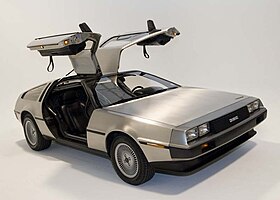De Lorean DMC-12
| DeLorean DMC-12 | |
|---|---|

1983 DeLorean DMC-12
|
|
| Overview | |
| Manufacturer | DeLorean Motor Company |
| Production | 8,583 |
| Model years | 1981–1983 |
| Assembly | |
| Designer | Giorgetto Giugiaro |
| Body and chassis | |
| Class | Sports car |
| Body style | 2-door gullwing coupé |
| Layout | RR layout |
| Powertrain | |
| Engine | 2,849 cc PRV ZMJ-159 V6 |
| Transmission | 5-speed manual 3-speed automatic |
| Dimensions | |
| Wheelbase | 2,413 mm (95.0 in) |
| Length | 4,216 mm (166.0 in) |
| Width | 1,857 mm (73.1 in) |
| Height | 1,140 mm (44.9 in) doors closed 1,961 mm (77.2 in) doors open |
| Curb weight | 1,230 kg (2,712 lb) |
The DeLorean DMC-12 (commonly referred to simply as "the DeLorean" as it was the only model ever produced by the company), is a sports car manufactured by John DeLorean's DeLorean Motor Company for the American market from 1981–83. The car features gull-wing doors and an innovative fiberglass body structure with a steel backbone chassis, along with external brushed stainless steel body panels. The car became widely known and iconic for its appearance and was modified as a time machine in the Back to the Future media franchise.
The first prototype appeared in October 1976. Production officially began in 1981 in Dunmurry, a suburb of southwest Belfast, Northern Ireland, where the first DMC-12 rolled off the production line on January 21. Over the course of production, several features of the car were changed, such as the hood style, wheels and interior. About 9,000 DMC-12s were made before production halted in early 1983.
The DMC-12 was the only model produced by the company, which was later liquidated as the US car market went through its largest slump since the 1930s. In 2007, about 6,500 DeLorean Motor cars were believed still to exist.
British entrepreneur Stephen Wynne, based in Texas, started a separate company in 1995 using the "DeLorean Motor Company" name and shortly thereafter acquired the trademark on the stylized "DMC" logo as well as the remaining parts inventory of the original DeLorean Motor Company. The company, at its suburban Humble, Texas, location, builds new cars from (NOS) parts, original equipment manufacturer (OEM) and reproduction parts on a "made to order" basis using existing vehicle identification number (VIN) plates.
On January 27, 2016, the new DMC announced that it would build 300 DMC-12 cars in late 2016 and "new" DMC-12s in early 2017, each projected to cost just under $100,000.
In October 1976, the first prototype DeLorean DMC-12 was completed by American automotive chief engineer William T. Collins, formerly chief engineer at Pontiac. Originally, the car was intended to have a centrally-mounted Wankel rotary engine. The engine selection was reconsidered when Comotor production ended, and the favored engine became Ford's "Cologne V6." Eventually the French/Swedish PRV (Peugeot-Renault-Volvo) fuel injected V6 was selected. Also the engine location moved from the mid-engined location in the prototype to a rear-engined installation in the production car. The chassis was initially planned to be produced from a new and untested manufacturing technology known as elastic reservoir moulding (ERM), which would lighten the car while presumably lowering its production costs. This new technology, for which DeLorean had purchased patent rights, was eventually found to be unsuitable.
...
Wikipedia
